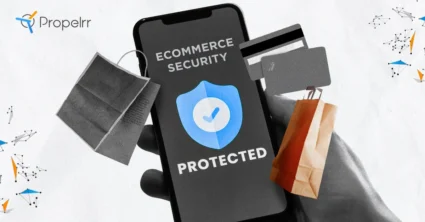Ecommerce Security: Top Threats and How to Mitigate Them
Author & Editor
Senior Software Engineer
Published on: Nov 28, 2022 Updated on: May 28, 2024

Table of Contents
As transactions continue growing so do the ecommerce security threats as these platforms are becoming more attractive avenue for hackers to exploit.
To began with ecommerce security has always been an imperative in web design and development.
But as the pandemic sparked accelerated growth in the ecommerce industry, the more it becomes a prized boon for negative agents online. Now, they are more motivated than ever to illegally access and exploit the data acquired in these transactions.
In fact, according to recent cyber statistics, three out of five companies get hit by supply chain attacks in 2021. What’s more concerning is that many tech leads report not being unable to anticipate attacks.
The cost of cyber-attacks
The cost of cyber-attacks can be significant for both online shoppers and merchants. In addition to the financial costs, these attacks can also have a negative impact on a business's reputation.
For online shoppers, the cost of cyber-attacks can range from the loss of personal information to the theft of funds. In some cases, online shoppers may not be able to recover their losses, which can result in significant financial damages.
For merchants, the cost of cyber-attacks can be even higher. In addition to the financial damages, these attacks can also lead to the loss of customers and revenue.
These combined factors make it critical for both merchants and users to be vigilant whenever and wherever they transact online.
To do this, an awareness of the types of cyber-security attacks can best guide you towards preventing or mitigating them.
After all, you can respond to a threat if you know what kind of threat it is.
Types of ecommerce security threats and cyber-attacks
Merchants and customers alike frequently fall prey to cyber-attacks. Below are the most common types of threats, so that you can plan to respond accordingly.
1. Illegal access to information
The most common type of attack is a cyber-attack is when a hacker gains access to a computer or network to steal information or damage a system.
ECommerce websites are a prime target for this type of cyber-attack because they contain sensitive information such as credit card numbers and personal data of customers.
This data, once accessed, can be sold to malicious operators or used for the hacker’s personal gain. This makes it imperative that you bolster customer data privacy on your ecommerce and other websites.
ADDITIONAL READING: How to Protect Customer Data Privacy in Digital Marketing
2. Phishing schemes
Are a type of cyber-security threat where hackers send fraudulent emails or texts to try and trick people into giving their personal information willingly.
These scams will often look like a regular email from a merchant or entity that people commonly transact with. It will make use of emails with small, unnoticeable discrepancies in the address and contain links that will direct you to landing pages where your data can be collected.
These are particularly dangerous because they can be very difficult to detect. Many ecommerce websites have been victims of phishing attacks in the past, including Amazon, PayPal and eBay.
3. Malicious software (malware) attacks
Is a cyber-attack that involves the use of malicious software like viruses, worms, spyware, ransomware, adware, and trojans.
Each type of malware functions differently and causes different types of damage to a website or computer. Spyware, for example, steals confidential data without your knowledge.
4. Distributed denial of service (DDoS) attacks
This is when a hacker sends overwhelming amounts of traffic to a website. This can lead to server overload causing it to crash or become unavailable.
How you can protect yourself against cyber-attacks
Ecommerce security is of utmost importance for both online shoppers and merchants. Despite the many measures that have been put in place to protect both groups, ecommerce security issues continue to persist.
For merchants and customers alike, it’s always best to remain vigilant whenever transacting online.
Each can take specific measures for protection, as recommended below.
Security tips for merchants:
- Implement strong passwords and security measures.
- Install anti-virus and malware protection on your computer and devices.
- Educate your employees about phishing scams and other types of online threats.
- Use secure payment methods such as credit cards instead of debit cards.
- Regularly update your software and firmware patches.
- Have a contingency and response plan in place in case your website is attacked.
- Install firewalls and malware protection software.
- Regularly backup your data.
Security tips for shoppers
- Never click dubious links or download attachments from suspicious emails.
- Browse only on websites that have a secure browser extension like HTTPS.
- Never provide your personal information unless you are sure the site is reputable.
- Check the security features of a site before entering any personal information.
- Keep your computer's security software up to date.
Key takeaways
Vigilance on both the side of the merchant and customer are critical to remaining safe against cyber-attacks. While keeping these tips in mind, remember as well that:
- Always be prepared. Many attacks happen unprecedentedly and when you are most vulnerable. Be constantly prepared to defend and mitigate these attacks.
- It helps to have an extra hand. If you can, employ third-party developers that can be tapped to assist during an ongoing attack.
- Be an advocate for data privacy protection. Though it’s common knowledge for the digitally literate, cyber-attacks are done on the most vulnerable and unknowing. Help keep others safe by advocating and increasing awareness for cyber-security and data privacy protection.
Do you have a response framework for cyber-attacks? Share them with us on Facebook, X, or LinkedIn. We’d love to learn from you as well.
For more comprehensive tips on how you can bolster ecommerce site security, subscribe to our newsletter. We’ll make sure to deliver them straight to your inbox.
